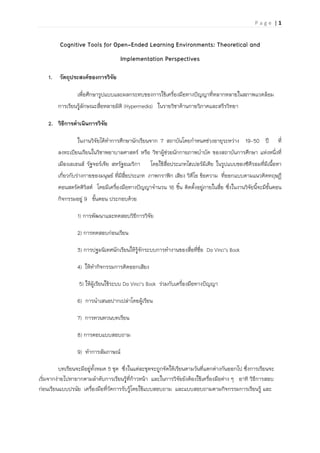
Cognitive tools for open Learning Environment
- 1. P a g e | 1 Cognitive Tools for Open-Ended Learning Environments: Theoretical and Implementation Perspectives 1. วัตถุประสงค)ของการวิจัย เพื่อศึกษารูปแบบและผลกระทบของการใชเครื่องมือทางปญญาที่หลากหลายในสภาพแวดลอม การเรียนรูลักษณะสื่อหลายมิติ (Hypermedia) ในรายวิชาดานกายวิภาคและสรีรวิทยา 2. วิธีการดําเนินการวิจัย ในงานวิจัยไดทําการศึกษานักเรียนจาก 7 สถาบันโดยกําหนดช;วงอายุระหว;าง 19-50 ปB ที่ ลงทะเบียนเรียนในวิชาพยาบาลศาสตรC หรือ วิชาผูช;วยนักกายภาพบําบัด ของสถาบันการศึกษา แห;งหนึ่งที่ เมืองเอเธนสC รัฐจอรCเจีย สหรัฐอเมริกา โดยใชสื่อประเภทไฮเปอรCมีเดีย ในรูปแบบของซีดีรอมที่มีเนื้อหา เกี่ยวกับร;างกายของมนุษยC ที่มีสื่อประเภท ภาพกราฟJก เสียง วิดีโอ ขอความ ที่ออกแบบตามแนวคิดทฤษฏี คอนสตรัคติวิสตC โดยมีเครื่องมือทางปญญาจํานวน 16 ชิ้น ติดตั้งอยู;ภายในสื่อ ซึ่งในงานวิจัยนี้จะมีขั้นตอน กิจกรรมอยู; 9 ขั้นตอน ประกอบดวย 1) การพัฒนาและทดสอบวิธีการวิจัย 2) การทดสอบก;อนเรียน 3) การปฐมนิเทศนักเรียนใหรูจักระบบการทํางานของสื่อที่ชื่อ Da Vinci’s Book 4) ใหทํากิจกรรมการคิดออกเสียง 5) ใหผูเรียนใชระบบ Da Vinci’s Book ร;วมกับเครื่องมือทางปญญา 6) การนําเสนอปากเปล;าโดยผูเรียน 7) การทวนทวนบทเรียน 8) การตอบแบบสอบถาม 9) ทําการสัมภาษณC บทเรียนจะมีอยู;ทั้งหมด 5 ชุด ซึ่งในแต;ละชุดจะถูกจัดใหเรียนตามวันที่แตกต;างกันออกไป ซึ่งการเรียนจะ เริ่มจากง;ายไปหายากตามลําดับการเรียนรูที่กาวหนา และในการวิจัยยังตองใชเครื่องมือต;าง ๆ อาทิ วิธีการสอบ ก;อนเรียนแบบปรนัย เครื่องมือที่วัดการรับรูโดยใชแบบสอบถาม และแบบสอบถามตามกิจกรรมการเรียนรู และ
- 2. P a g e | 2 นอกจากยังใชเทคนิคอีก 5 อย;าง อาทิ เทคนิคการแสดงออก เทคนิคการคิดออกเสียง เทคนิคการทวนสอบ เทคนิคการสัมภาษณC และ เทคนิคการวิเคราะหCผลิตภัณฑC 3. ผลการวิจัย ผลของการวิจัยพบว;าการทํางานของเครื่องมือสามารถสนับสนุนกระบวนการทางปญญาไดเป^น อย;างดี โดยมีการรายงานจากผูเรียนว;าผลของการใชสื่อทําใหการรับรูของผูเรียนดีขึ้น 4. การนําผลการวิจัยไปประยุกต)ใช? จากผลการวิจัยที่เกิดการการนําเครื่องมือทางปญญาไปใชร;วมกับสื่อที่เรียกว;า Da Vinci’s Boo พบว;าเครื่องมือแต;ละประเภทสามารถช;วยผูเรียนใหเกิดการเรียนรู โดยอาศัยคุณสมบัติของแต;ละประเภท เช;น เครื่องมือสําหรับการสืบคนขอมูล เครื่องมือนําเสนอขอมูล เครื่องมือที่ใชสรางความรู เป^นตน ซึ่ง คาดว;าถามีการนําหลักการ หรือเครื่องมือทางปญญาเหล;านี้ ไปใชร;วมกับสื่อในสาขาวิชาอื่น ๆ จะสามารถ เสริมศักยภาพการเรียนรูของผูเรียนไดดียิ่งขึ้น เช;น สื่อในสาขาวิชาทางดานกฎหมาย ที่มีความซับซอน ตองอาศัยการจดจําเนื้อหา คิดวิเคราะหCไตร;ตรอง ซึ่งคาดว;าจะสามารถนําหลักการที่ไดจากงานวิจัยพรอม เครื่องมือทางปญญาไปสนับสนุนใหผูเรียน ประสบความสําเร็จในการเรียนรูไดเป^นอย;างดี 5. ข?อค?นพบที่เกี่ยวข?องกับ Educational Emerging Technology จากงานวิจัยดังกล;าว เป^นการศึกษาที่เนนการใชเครื่องมือที่สนับสนุนการเรียนรูเฉพาะตัวบุคคล ไม;ไดเนนที่กลุ;มบุคคล ซึ่งผูวิจัยไดเล็งเห็นถึงเทคโนโลยีที่เกิดใหม; อาทิ เทคโนโลยีเว็บ หรือ โซเชียล เน็ตเวิรCค เทคโนโลยี ที่จะมาต;อยอดงานวิจัยในลักษณะการศึกษาเครื่องมือทางปญญาในระดับสังคม (Social Cognitive) ซึ่งจะสามารถขยายขอบข;ายของงานไดกวางขวางยิ่งขึ้น
- 3. P a g e | 3 Functional Tool Classifications Roles of Tools Principles of Design and Use Example Tools 1. Information Seeking Tools • Support learners as they attempt to identify and locate relevant information • Support learners to retrieve new and existing knowledge • Provide multiple perspectives via varied information seeking strategies (Cognitive Flexibility Theory) • Support learners in monitoring their information seeking activities (Meta cognitive Theory) Alphabetical Index Bookmark General Index Hyper picture Hypertext Health &Diseases Keyword Search Map & Guide Mechanism Path Tracker Reviewer Structure Map Text Memo Visual History Voice Memo Google Search 2. Information Presentation Tools • Support learners as they attempt to present the information they encounter • Assist in clarifying the relationship among the information • Provide multi-modal representations (Cognitive Flexibility Theory) • Reduce demands on working memory(Cognitive Load Theory) Bookmark Presentation Maker Mechanism Path Tracker Reviewer Structure Map Text Memo Visual History Voice Memo Dreamweaver Power point Pro show producer
- 4. P a g e | 4 Functional Tool Classifications Roles of Tools Principles of Design and Use Example Tools 3. Knowledge Organization Tools •Support learners as they attempt to establish conceptual relationships in to-be-learned information •Help learners to interpret, connect, and organize the represented information meaningfully • Avoid over simplifications of complex conceptual schemata( Cognitive Flexibility Theory) • Help learners to simplify unnecessarily complex cognitive tasks (Cognitive Load Theory) • Facilitate self-regulated organization (Meta cognition Theory) Bookmark Hyper picture Hypertext Map & Guide Mechanism Structure Map Text Memo Voice Memo My Mapping tool Blog 4. Knowledge Integration Tools •Support learners in connecting new with existing knowledge •Facilitate the processing of content at deeper levels in order to construct personally meaningful knowledge • Facilitate the sophistication of conceptual understanding (Mental model theory) • Help learners to monitor knowledge construction process as well as their knowledge status (Meta cognition Theory) Presentation Maker Text Memo Voice Memo Wikipedia 5. Knowledge Generation Tools •Support the manipulation and generation of knowledge •Help learners to represent their newly generated knowledge flexibly and meaningfully • Encourage multiple perspective and multi- modal knowledge generation(Cognitive Flexibility Theory) • Allow learners to select varied cognitive strategies(Meta cognition Theory) Presentation Maker Text Memo Voice Memo LOGO computer language
- 5. P a g e | 5 ผูร;วมงาน ประกอบดวย 1. นางกนกพิชญC อนุพันธC รหัสประจําตัว 575050178-6 2. นายโฆษิต จํารัสลาภ รหัสประจําตัว 575050179-4 3. นายรณฤทธิ์ ธรรมาธิกร รหัสประจําตัว 575050188-3 4. นางสาวอิสยาหC ถือสยม รหัสประจําตัว 575050200-9 นักศึกษาสาขาเทคโนโลยีการศึกษา ระดับปริญญาโท (โครงการพิเศษ)